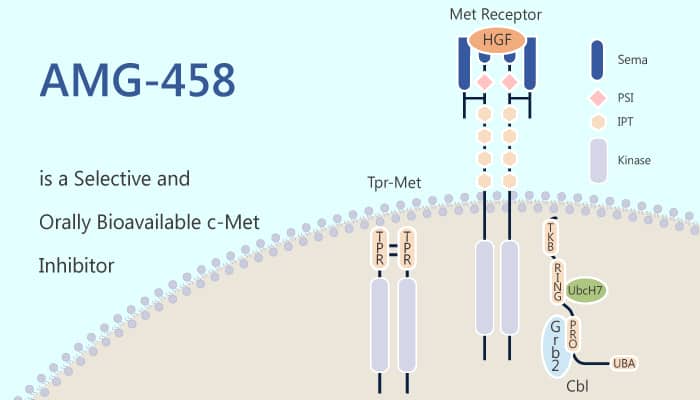C-met is a protein encoded by a met gene in humans, which has tyrosine kinase activity. Specifically, Met is an essential one-way tyrosine kinase receptor for embryonic development, organogenesis, and wound healing. Besides, C-met is a receptor tyrosine kinase that can be activated by its ligand, hepatocyte growth factor/dispersion factor (HGF/SF). After c-met activation, the intracellular C-terminal docking domain recruits and activates a series of downstream signaling molecules. Moreover, this contributes to cell survival, proliferation, migration, and invasion. Overexpression of HGF and/or c-met or activation mutation of c-met are relevant to human cancer. Furthermore, the inhibition of c-met kinase activity by small molecules may block ligand-dependent and ligand-independent activation of c-met. Dual c-met/ALK inhibitors showed antitumor effects in xenograft models expressing activated c-met. AMG-458 is a potent, selective, and orally bioavailable c-Met inhibitor.

AMG-458 is a potent, selective, and orally bioavailable c-Met inhibitor.
But, how does AMG-458 protect against cancer cells via c-Met? Let’s discuss it in detail. In the beginning, AMG-458 is an orally bioavailable c-Met inhibitor, with Ki values of 1.2 nM and 2.0 nM for human and mouse c-Met, respectively. Meanwhile, AMG-458 inhibits c-Met with IC50s of 60 nM, 120 nM, 690 nM for PC3, CT26, Huvec cells.
In addition, AMG-458 significantly inhibited tumor growth in the NIH3T3/TPR-Met and U-87 MG xenograft models with no adverse effect on body weight. Nonetheless, AMG-458 has an ED50 of ∼12 mg/kg and an ED90 of ∼ 34 mg/kg in the NIH-3T3/TPR-Met model. Importantly, AMG-458 has an ED50 of ∼16 mg/kg and an ED90 of ∼ 59 mg/kg in the U-87 MG human glioblastoma xenograft model. Particularly, AMG-458 exhibited CL ((L/h)/kg) values of 0.16 and 0.73, Vss (L/kg) values of 0.31 and 0.62, t1/2 (h) values of 1.3 and 1.0 in mouse and rat, respectively.
All in all, AMG-458 is a potent, selective, and orally bioavailable c-Met inhibitor with
References:
Longbin Liu, et al. J Med Chem. 2008 Jul 10;51(13):3688-91.